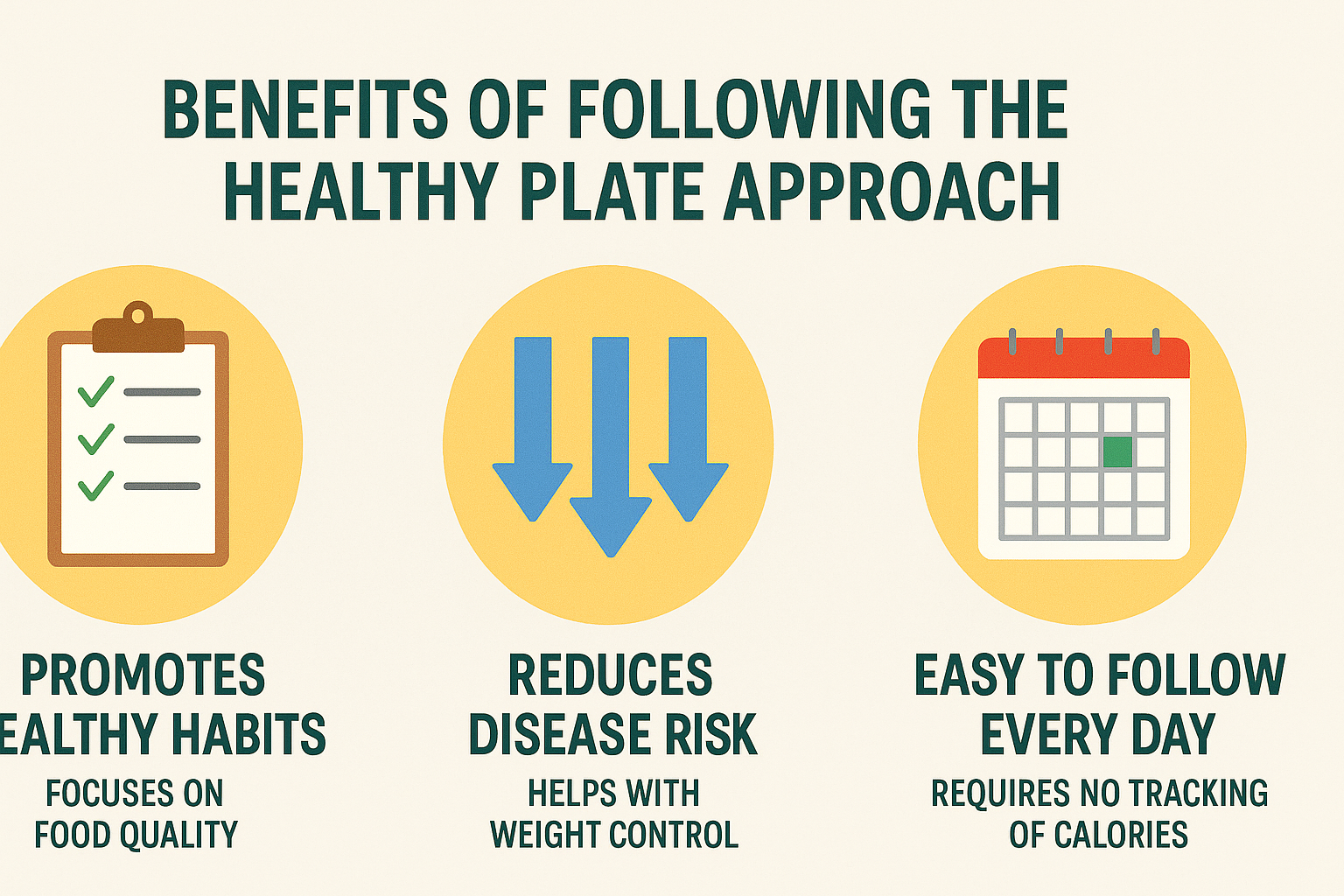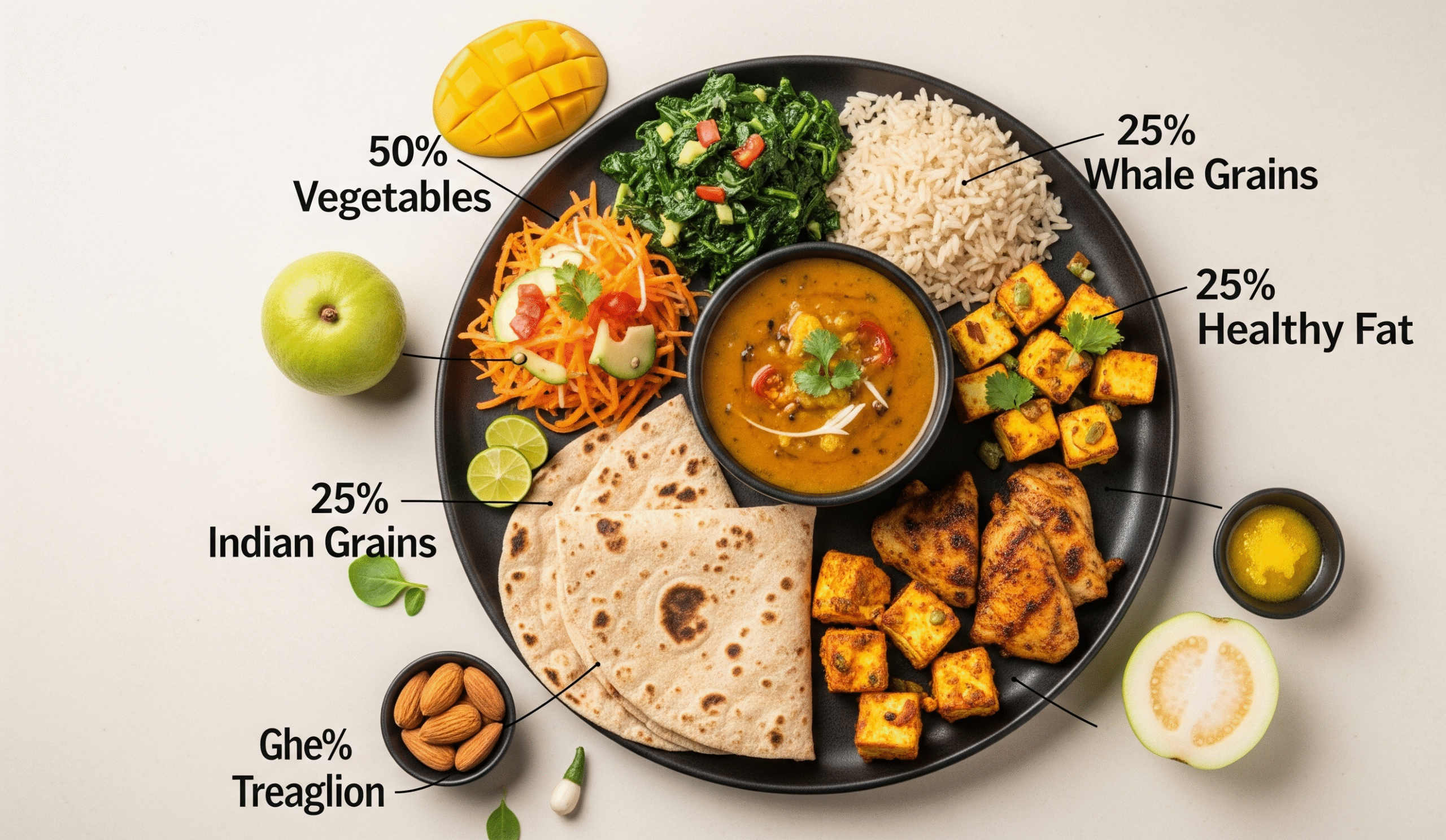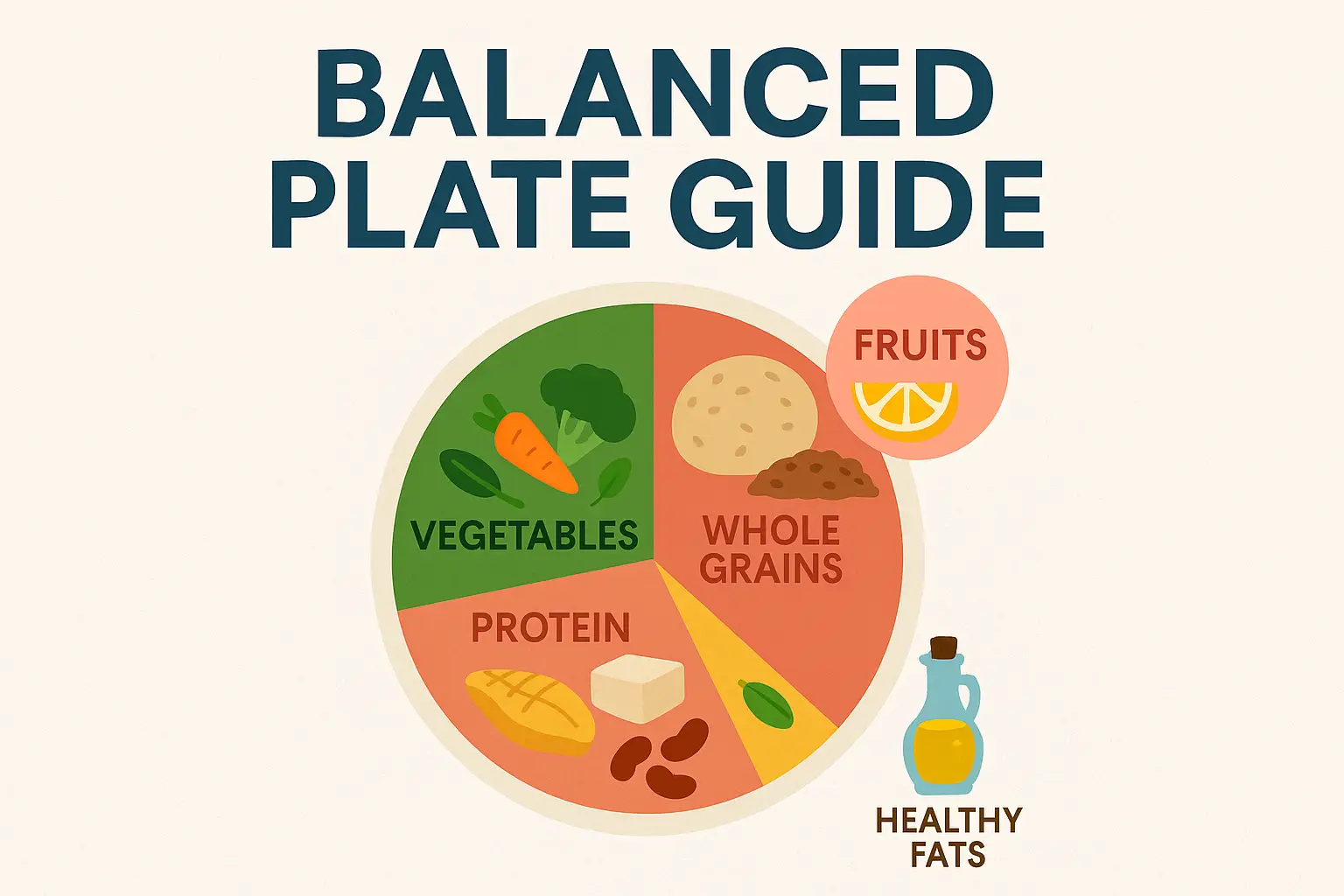The balanced plate guide offers a straightforward approach to achieving optimal nutrition, sustained energy, and long-term health, tailored especially for Indian diets. Whether you’re savoring a traditional Indian thali, enjoying a modern meal bowl, or grabbing a quick snack on the go, this nutrition guide helps you make informed food choices that fuel your body and fit seamlessly into your lifestyle. By following this healthy eating method, you can create nutrient-rich meals without the complexity of calorie counting or restrictive diets.
This comprehensive guide breaks down the essentials of food groups, portion sizes, and practical tips to craft healthy meals that align with your cultural and personal preferences. With a focus on Indian cuisine, it ensures that healthy eating is both practical and flavorful, making it accessible to everyone—from busy professionals to home cooks.
What is a Balanced Plate Guide and Why It Works

The balanced plate guide is a visual, evidence-based approach to meal planning that ensures every meal includes the right proportions of macronutrients (carbohydrates, proteins, and fats) and micronutrients (vitamins and minerals). By structuring your plate with 50% vegetables, 25% whole grains, 25% protein, plus a side of fruit and a small amount of healthy fats, this healthy plate method creates nutrient-dense meals that support overall health. Rooted in guidelines from the Indian Council of Medical Research (ICMR), it simplifies nutrition by emphasizing portion control and variety.
This nutrition guide eliminates the need for complex calculations, making it ideal for Indian diets rich in dals, rotis, and sabzis. Whether you’re preparing a traditional thali or a modern quinoa bowl, the balanced plate guide adapts to your preferences while ensuring nutritional balance. It’s particularly effective for Indian households, where diverse ingredients like millets, lentils, and spices are staples, making healthy eating both practical and culturally relevant.
Why It Matters
Adopting a healthy plate method offers numerous benefits that enhance both immediate well-being and long-term health:
- Boosts Energy and Stamina: Combining complex carbohydrates, proteins, and healthy fats provides sustained energy, preventing mid-day crashes.
- Supports Digestive and Metabolic Health: High-fiber vegetables and fruits promote healthy digestion, while balanced macronutrients stabilize blood sugar levels.
- Controls Weight Naturally: Proper portion sizes and nutrient variety help manage appetite and prevent overeating, supporting healthy weight maintenance.
- Reduces Lifestyle Disease Risk: By emphasizing whole foods, this approach lowers the risk of chronic conditions like type 2 diabetes, heart disease, and hypertension.
- Simplifies Meal Planning: The 50-25-25 rule (50% vegetables, 25% whole grains, 25% protein) makes meal prep intuitive, eliminating the need for calorie counting.
This balanced plate guide empowers you to create meals that are both delicious and nutritious, ensuring your body receives the fuel it needs to thrive. The Indian Council of Medical Research (ICMR) recommends following the healthy plate portions approach to simplify meal planning without calorie counting.
The Five Food Groups for a Balanced Plate
The balanced plate guide revolves around five key food groups, each playing a unique role in supporting your health. By incorporating these groups in the right proportions, you create a harmonious, nutrient-packed meal.
1. Vegetables (Fill Half Your Plate)
Vegetables are the cornerstone of the balanced plate guide, occupying 50% of your plate. They are low in calories but rich in fiber, vitamins (A, C, K, folate), minerals (potassium, magnesium), and antioxidants, which combat inflammation and support overall health.
- Daily Recommendation: 300–400 grams (about 2–3 cups).
- Indian Examples: Spinach (palak), carrots (gajar), okra (bhindi), cauliflower (gobi), bottle gourd (lauki), green beans, eggplant (baingan), and bell peppers.
- Indian Dishes: Mixed vegetable sabzi, stir-fried veggies with spices, raw salads (kachumber), or steamed vegetables with cumin or mustard seeds.
- Tip: Use a variety of colors (green, red, yellow, orange, purple) in the balanced plate guide to ensure a diverse range of nutrients. For example, pair green spinach with red bell peppers or orange carrots.
Vegetables add bulk and satiety to meals, making them a vital component of the balanced plate guide. In Indian cuisine, they shine in sabzis, curries, and side dishes, making it easy to meet the 50% requirement.
2. Fruits (One-Fourth of Your Plate or As Snacks)
Fruits provide essential vitamins (like vitamin C and folate), minerals, and fiber, while their natural sugars offer a healthy energy boost. The balanced plate guide recommends including fruits as part of your plate or as snacks.
- Daily Recommendation: 100–150 grams (1–2 medium fruits).
- Indian Examples: Guava, banana, apple, mango, chikoo (sapota), custard apple (sitaphal), pomegranate, or seasonal berries.
- Indian Favorites: Fruit chaat with chaat masala, sliced mango, or a bowl of mixed seasonal fruits with a squeeze of lemon.
- Tip: Choose whole fruits over juices in the balanced plate guide to retain fiber and avoid added sugars, which can spike blood sugar levels.
Fruits add a refreshing, naturally sweet element to the balanced plate guide, making them ideal for satisfying cravings healthily.
3. Whole Grains (One-Fourth of Your Plate)
Whole grains are a key source of complex carbohydrates, fiber, and B vitamins in the balanced plate guide, providing sustained energy and supporting digestive health. They form 25% of your plate.
- Daily Recommendation: 100–150 grams (about ¾–1 cup cooked).
- Indian Examples: Brown rice, whole wheat roti, millets (jowar, bajra, ragi), quinoa, oats, or barley.
- Tip: Opt for whole grains over refined grains (like white rice or maida) in the balanced plate guide to maximize nutrient intake and maintain stable blood sugar levels.
Millets like ragi and jowar are nutrient-dense staples in Indian cuisine, making them perfect for the balanced plate guide.
4. Protein (One-Fourth of Your Plate)
Protein is essential for muscle repair, immune function, and satiety in the balanced plate guide, occupying 25% of your plate.
- Daily Recommendation: 0.8–1 gram per kilogram of body weight (about 50–70 grams for most adults).
- Vegetarian Sources: Lentils (dal), chickpeas (chana), kidney beans (rajma), paneer, tofu, sprouts, or curd.
- Non-Vegetarian Sources: Chicken, fish, eggs, or lean meats like mutton in moderation.
- Tip: Combine grains and legumes (e.g., rice and dal) in the balanced plate guide to form complete proteins with all essential amino acids.
Protein-rich foods are abundant in Indian cuisine, making it easy to meet your needs with the balanced plate guide.
5. Healthy Fats (Use in Small Amounts)
Healthy fats support brain health, hormone production, and nutrient absorption in the balanced plate guide. They add flavor but should be used sparingly.
- Daily Recommendation: 20–30 grams (about 1–2 tablespoons).
- Sources: Ghee, mustard oil, olive oil, coconut oil (in moderation), almonds, walnuts, flax seeds, sesame seeds, or avocado.
- Tip: Avoid trans fats and limit saturated fats in the balanced plate guide. Use cold-pressed oils or nuts for healthier options.
In Indian cooking, healthy fats like ghee or mustard oil enhance flavor while supporting the balanced plate guide’s nutritional goals.
Visual Guide for Indian Meals
This healthy eating method follows a simple formula: 50% Vegetables + 25% Whole Grains + 25% Protein + a Side of Fruit + a Small Amount of Healthy Fat. The following table ensures your meals are balanced and satisfying.

| Section | Portion | Indian Examples |
|---|---|---|
| Vegetables | 50% | Palak sabzi, carrot salad, bhindi fry |
| Whole Grains | 25% | Brown rice, 2 whole wheat rotis, millet khichdi |
| Proteins | 25% | Moong dal, paneer bhurji, grilled chicken |
| Fruits | Side | Mango slices, guava, pomegranate seeds |
| Healthy Fats | Small | 1 tsp ghee, 10 almonds, 1 tsp olive oil |
Pro Tip: Use a 9-inch plate in the balanced plate guide to control portion sizes. Larger plates can lead to overeating, while a 9-inch plate aligns with the 50-25-25 rule.
Sample Indian Balanced Plates

These sample meals demonstrate how to apply the balanced plate guide to Indian diets for breakfast, lunch, and dinner, incorporating the five food groups in the recommended proportions.
Breakfast Example: Ragi Porridge with Fruit and Nuts
- Vegetables: ½ cup sautéed spinach with cumin and garlic.
- Whole Grains: 1 cup ragi porridge (made with milk or water).
- Proteins: 1 boiled egg or ¼ cup crumbled paneer.
- Fruits: ½ cup chopped papaya or chikoo.
- Healthy Fats: 5 almonds or 1 tsp ghee.
Why It Works: Ragi, a nutrient-dense millet, provides calcium and fiber in the balanced plate guide. Spinach adds vitamins, while the egg or paneer ensures protein for satiety. Papaya offers vitamin C, and almonds provide healthy fats.
Lunch Example: Classic Indian Thali
- Vegetables: 1 cup mixed vegetable sabzi (cauliflower and peas) + ½ cup kachumber salad.
- Whole Grains: 2 whole wheat rotis or ¾ cup brown rice.
- Proteins: 1 cup moong dal or 100 grams paneer bhurji.
- Fruits: ½ cup pomegranate seeds or a small banana.
- Healthy Fats: 1 tsp ghee drizzled over dal.
Why It Works: This thali follows the balanced plate guide with fiber-rich vegetables, protein-packed dal, and complex carbs from rotis. The fruit adds micronutrients, and ghee enhances flavor and nutrition.
Dinner Example: Brown Rice Pulao with Chicken or Tofu
- Vegetables: 1 cup mixed vegetables (carrots, beans, peas) in pulao + ½ cup cucumber raita.
- Whole Grains: ¾ cup brown rice pulao.
- Proteins: 100 grams grilled chicken or tofu.
- Fruits: 1 medium apple or a handful of grapes.
- Healthy Fats: 1 tsp olive oil or 8–10 walnuts.
Why It Works: Brown rice provides sustained energy in the balanced plate guide, while vegetables and protein ensure a nutrient-dense meal. Raita adds probiotics, and the fruit serves as a light dessert.
Customizing Your Balanced Plate
The balanced plate guide is flexible, accommodating various dietary preferences common in India.
Vegetarian Plate
- Example: Rajma curry (protein) + brown rice (whole grain) + bhindi sabzi (vegetables) + guava slices (fruit) + 1 tsp mustard oil or 10 peanuts (healthy fat).
- Tip: Use a variety of legumes and dairy-based proteins like paneer or curd in the balanced plate guide to meet protein needs.
Vegan Plate
- Example: Quinoa salad with chickpeas (protein + whole grain) + stir-fried broccoli and bell peppers (vegetables) + mango slices (fruit) + lemon-tahini dressing (healthy fat).
- Tip: Incorporate tofu, tempeh, or nutritional yeast in the balanced plate guide for protein variety, and use nut-based dressings or seeds for healthy fats.
Low-Carb/Keto Plate
- Example: Cauliflower rice (low-carb grain substitute) + grilled paneer or chicken (protein) + sautéed spinach and mushrooms (vegetables) + ½ avocado (fruit + healthy fat).
- Tip: Focus on non-starchy vegetables and use almond or coconut flour for roti substitutes in the balanced plate guide.
Practical Tips for Everyday Eating with the Balanced Plate Guide
These strategies make the balanced plate guide easy to implement in your daily routine:
- Plan Ahead: Prep grains, chop vegetables, or soak legumes on weekends to save time.
- Use Hand Portions:
- Vegetables: Two handfuls (1–1.5 cups).
- Grains: One fist-sized portion (¾ cup cooked).
- Protein: Palm-sized portion (100–150 grams).
- Fats: Thumb-sized portion (1 tsp oil or 8–10 nuts).
- Spice Smart: Use turmeric, cumin, or ginger to enhance flavor and health benefits in the balanced plate guide.
- Hydrate: Drink 2–3 liters of water daily, infusing with mint or lemon for variety.
- Shop Seasonal: Choose local, seasonal produce to reduce costs and maximize freshness.
- Batch Cook: Prepare large portions of dals or sabzis for the week.
- Mindful Eating: Eat slowly to improve digestion and satisfaction.
- Limit Processed Foods: Avoid sugary drinks and trans-fat-heavy snacks to align with the balanced plate guide.
Balanced Plate Weekly Planner (Sample)
This 7-day planner showcases the balanced plate guide in action for Indian diets.
| Day | Breakfast | Lunch | Dinner |
|---|---|---|---|
| Monday | Ragi porridge, egg, papaya | Roti, moong dal, mixed sabzi, guava | Brown rice pulao, tofu, cucumber salad |
| Tuesday | Poha with peas, curd, almonds | Rajma curry, brown rice, bhindi, banana | Grilled chicken, stir-fried veggies, apple |
| Wednesday | Dosa, sambar, chutney, mango | Paneer bhurji, roti, gobi sabzi, chikoo | Quinoa khichdi, salad, pomegranate |
| Thursday | Oats with milk, spinach, walnuts | Chana masala, millet roti, salad, orange | Fish curry, cauliflower rice, grapes |
| Friday | Besan cheela, curd, berries | Dal tadka, brown rice, lauki sabzi, pear | Tofu stir-fry, zucchini noodles, guava |
| Saturday | Idli, sambar, coconut chutney, banana | Chicken curry, roti, palak sabzi, apple | Millet pulao, paneer, salad, mango |
| Sunday | Upma with veggies, curd, almonds | Rajma, rice, carrot salad, pomegranate | Grilled fish, sautéed veggies, chikoo |
Tip: Adjust portions based on your needs and consult a dietitian for personalization in the balanced plate guide.
Portion Guide Table (Based on ICMR)
The balanced plate guide aligns with ICMR recommendations for daily nutrient intake.
| Food Group | Daily Recommended Amount | Hand Portion Estimate |
|---|---|---|
| Vegetables | 300–400 grams | Two handfuls |
| Fruits | 100–150 grams | One medium fruit |
| Whole Grains | 100–150 grams | One fist-sized portion |
| Proteins | 0.8–1 g/kg body weight | Palm-sized portion |
| Healthy Fats | 20–30 grams | Thumb-sized portion |
Health Benefits of the Balanced Plate
The balanced plate guide offers numerous health benefits:
- Energy Boost: Complex carbs and proteins provide sustained energy.
- Weight Management: Fiber and proper portions promote satiety.
- Better Digestion: High-fiber foods and hydration support gut health.
- Lower Disease Risk: Reduces risk of diabetes, heart disease, and obesity.
- Mental Clarity: Healthy fats and micronutrients support cognitive function.
- Improved Immunity: Vitamins and minerals strengthen the immune system.
Why This Balanced Plate Guide Works for You
The balanced plate guide is effective because it’s a sustainable habit, not a restrictive diet. Its simplicity, flexibility, and cultural relevance make it ideal for Indian diets, while its focus on whole foods ensures long-term health benefits. By following the 50-25-25 rule, you can enjoy delicious, nutrient-rich meals without complexity.
Ready to Take the First Step with the Balanced Plate Guide?
Start your journey with the balanced plate guide today:
- Apply the 50-25-25 rule to one meal.
- Download our free Wellness Starter Guide for planners and recipes.
- Explore vegetarian protein sources like lentils or paneer.
- Experiment with new vegetables, grains, or spices.
Frequently Asked Questions (FAQ)
1. What is the ideal plate size to use?
A 9-inch plate is ideal for the balanced plate guide, as it naturally controls portion sizes. Larger plates can lead to overeating, while a 9-inch plate aligns with the 50-25-25 rule.
2. Can I follow this guide on a budget?
Yes, the healthy eating method is budget-friendly:
Choose Seasonal Produce: Buy local vegetables and fruits like spinach or guava.
Buy in Bulk: Purchase grains and legumes in bulk.
Minimize Waste: Use vegetable peels for stocks or repurpose leftovers.
Cook at Home: Home-cooked meals are more affordable.
3. Is this guide suitable for diabetic or thyroid conditions?
The balanced plate guide is a safe foundation but may need adjustments:
Diabetes: Focus on low-glycemic foods (millets, non-starchy vegetables) and reduce grains.
Thyroid: Include iodine-rich foods (fish for non-vegetarians) and limit goitrogenic foods (raw cauliflower).
Consult a Professional: Work with a dietitian to tailor the plan.
4. What if I’m not hungry enough to eat all food groups?
Prioritize vegetables and protein, and include fruits or fats as snacks later. Listen to your hunger cues and adjust portions accordingly.
Disclaimer :
The information provided in this balanced plate guide is for general informational purposes only and is not intended as medical or nutritional advice. It is not a substitute for professional medical advice, diagnosis, or treatment. Always consult a qualified healthcare provider or registered dietitian before making significant changes to your diet, especially if you have medical conditions such as diabetes, thyroid disorders, or other health concerns. Individual nutritional needs vary based on age, activity level, health status, and other factors. The authors and publishers are not responsible for any adverse effects resulting from the use of this guide.
🔗 Relevant Blog Posts You Can Explore
To make your daily plate even better, don’t miss these:
- What Your Body Needs Every Day to Stay Healthy and Energized
- Macronutrients Made Simple – Proteins, Carbs, and Fats
- How to Plan a Healthy Meal Without Counting Calories
- Simple 7-Day Meal Plan for Busy People
- Protein-Rich Foods for Vegetarians in India

I’m a passionate wellness coach with over 5 years of experience helping people build healthier lives through balanced nutrition and practical lifestyle habits. I focus on science-backed guidance, including whole foods, mindful eating, and smart protein choices, to support energy, digestion, and long-term well-being. My approach is flexible, realistic, and built on the belief that prevention is better than cure because lasting health starts with daily choices.

